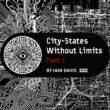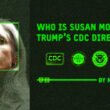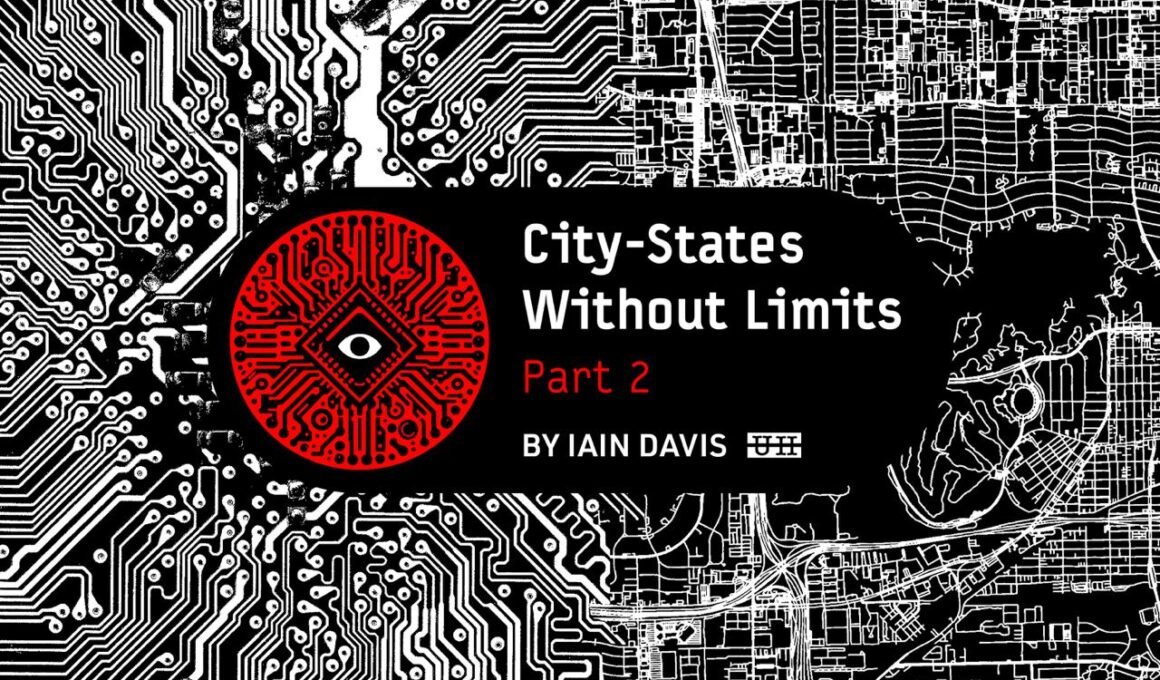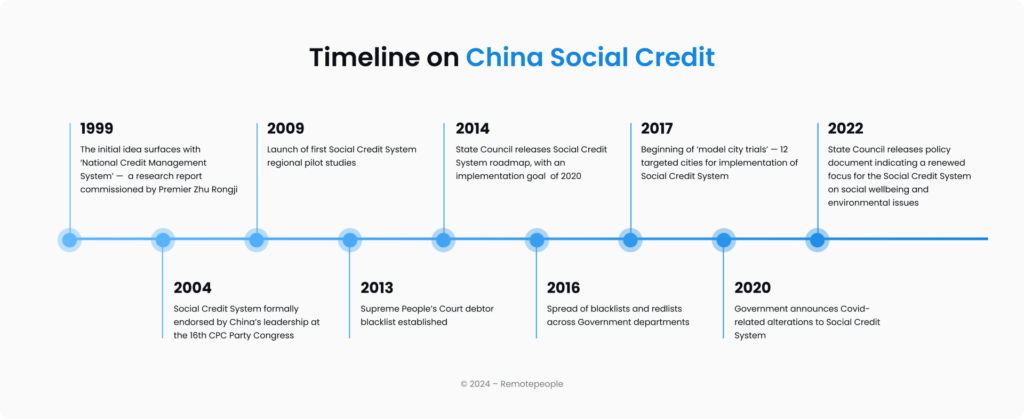In Part 1, we explored the ideology that has been adopted by a powerful group of NRx technocrat-oligarchs and how their proposals align with the interests of their international oligarch partners. We discussed the venture capital impact investment strategy the NRx technocrats call “accelerationism” and how governments are actually “functional oligarchies.”
The model of “government” the NRx technocrats propose is unlike anything we are currently familiar with. It is much more akin to the kind of authoritarian dictatorships exercised by the feudal monarchs of Medieval Europe. These gov-corp Technates, as envisaged, effectively amount to dictatorial city-states under the direct control of oligarchs.
The NRx technocrats seek to break nation-states apart into technologically governed “enclaves” (gov-corp Technates). These “realms” will form an international “Patchwork,” with each enclave or “network archipelago” represented as a digital node, almost certainly on a single, overarching blockchain or “unified ledger.” The digital access permissions to the node, which serves as the digital twin for the physical realm of the city-state “enclave,” will be controlled by the “founder” or their selected administrators of the realm. This forms a gov-corp Technate ruled by a CEO King (oligarch) where “nothing officially exists” unless it is represented digitally on the realm’s ledger (blockchain).
The citizens of the realm are customers of the sovereign corporation (sovcorp) that rules the gov-corp Technate. The customers will have no individual sovereignty unless they purchase it from the “founder.” All value is digital in the realm. The life of your “digital twin,” monitored through the requirement to use digital ID, seamlessly links a customer’s offline life to that of their online digital twin.
By controlling the programmable digital currency allotted to the customer’s digital twin, via their digital ID, any misbehaviour can be punished by the founder or their delegated system administrators. For example, by freezing “their deposits” or locking people “out of all doors for a time period as a punishment.” There are no means of recourse in a gov-corp Technate. The only option open to the persecuted customer is to flee, if they have the means.
We also discussed how governments around the world have already started carving out nascent gov-corp Technates in the form of thousands of Special Economic Zones (SEZs). Some of which, such as Shenzhen in China, have already been established as de facto city-states with their own increasingly independent jurisdictions and embryonic city-state governments.
At the heart of this effort to create a global patchwork of city-states are the NRx technocrats, perhaps most notably Peter Thiel, Elon Musk and Marc Andreessen in the US, and venture capital firms like NeWay Capital and Pronomos Capital. But they are far from alone. The NRx technocrat network is global and, at the highest governmental and intergovernmental level, the hope is to bring about the global governance of a patchwork of city-state gov-corp Technates.
Smart-City-States Without Limits
NRx technocrats want to create a global “patchwork” of digital surveillance societies where “nothing officially exists unless it’s on-chain.” All value is digital and the private founder[s], by virtues of the supreme sovereignty they have purchased with their investment, control their private fiefdoms as CEO “kings” of the ruling corporations. In effect, by exploiting digital technology and, most notably, Artificial Intelligence (AI), the NRx technocrats want to create a global network of privately financed smart-cities.
A smart-city can be said to be “an urban area where technology and data collection help improve [. . .] the sustainability and efficiency of city operations. [. . .] Technologies to collect data—including real-time data—are central to smart-city initiatives.” The objective of smart-city design is to control the urban environment and its inhabitants’ behaviour.
Taking a positive view of smart-city behavioural control, researchers from the Indonesian Journal of Information Systems and Informatics nonetheless noted:
The influence of smart city technology on consumer behavior in urban environments and people’s daily routines and lifestyle habits is significant. [. . .] The development of smart-cities through the application of various technologies such as smart transportation systems, traffic management applications, and smart sensors [. . .] has changed the behavior of people. [. . .] Thus, the application of smart city technology not only transforms city infrastructure and services, but also brings significant changes in citizen behavior.
Though behavioural control exercised by smart-city operators could possibly be benign, it could also be abused by despots to effectively program our lives. That is certainly what the NRx technocrats have in mind—engineering the “unthinking demos” whose sovereignty will be treated with “derision.” Regardless of the risks, smart-cities are being constructed the world over.
The China Global Television Network (CGTN) is part of the state-run China Media Group. In July of this year, CGTN reported how the Chinese government was “accelerating” the development of smart-cities. CGTN revealed that Shenzhen won an international award for smart-city of the year from the 2024 Smart-City Expo World Congress (SCEWC).
The SCEWC emphasised how the congress was impressed with Shenzhen’s application of the Chinese “Smarter City, Better Life” policy initiative that seeks to address “urban challenges” through the rapid deployment of technology. Just like the NRx technocrats in the West, Chinese policy think tanks apparently see technology as the solution; full stop.
The SCEWC said:
The initiative has pursued an aggressive digital transformation strategy to address these challenges across various sectors. Key components include the development of high-speed broadband networks, using digital twin technology to model and manage city systems, and integrating artificial intelligence and data-driven governance into city operations. [. . .] The city has also fostered an environment that encourages technological innovation and has attracted significant investment from private companies developing smart-city technologies.
Again, there is no notable difference between the stakeholder capitalist—public-private partnership—finance model for smart-city construction in China’s SEZs than that found anywhere else.
The SCEWC continued:
Shenzhen has pioneered the “4321+X” model for smart community development, emphasizing integrating government networks, video networks, IoT sensor networks, and the internet to create comprehensive data and service platforms. These platforms provide a foundation for various smart city applications, including public safety management, community governance, and the delivery of public services.
The 4321+X smart-city “community” is controlled based upon a set of clearly defined processes. The “4” refers to the integration of four data networks: the government’s network, private community CCTV networks, the internet, and specifically the Internet of Things (IoT). The “3” relates to the three areas of community activity to be integrated within and surveilled through the four networks: all business, public security (public conduct), and the local governance of services, including local security services. The “2” Refers to two major service sectors—called “platforms”—that combine to effect the monitoring of the three key areas of activity linked to the four networks. The two “platforms” are local government and law enforcement.
Finally, the “1” refers to the master database which, when Distributed Ledger Technology (DLT)—such as blockchain—is used, could be called the “unified ledger.” The ledger ties all the surveillance of the entire smart-city, combining 4, 3, and 2 together, into one centrally administered smart-city system. The smart-city supposedly facilitates “X” which is the artificially intelligent delivery of governance and services to the citizen.
The unified ledger (“1”) is monitored and controlled by the “Urban Brain” or “City Brain” which is the central command system for the smart-city. The Urban Planning Society of China—a non-governmental organisation (NGO) that operates by approval from China’s Ministry of Construction and Ministry of Civil Affairs—states that the purpose of the “Urban Brain” is to allocate “public resources” and enhance “social governance” in order to provide “new pathways for promoting sustainable economic and social development.”
As we noted in Part 1, China’s modern technological innovation is overwhelmingly the result of public-private partnership. In Hangzhou, for instance, the City Brain is managed by one global corporation:
Alibaba is the powerhouse of the technology from data platforms to advance analytics algorithm that enables all the smart city application.
In NRx technocrat terms, Alibaba Group is the sovereign corporation (sovcorp) of the city of Hangzhou, with a considerable ability to potentially control the lives of its nine million citizens or “customers.” As with all smart-city developments, the media only reports the realised or projected social benefits. The likely pitfalls are studiously ignored. To understand the danger we all face, if we take to living in such cities, we first need to consider how social credits systems are intended to work.
There are many, persistent myths peddled in the West about China’s Social Credit System (SCS). The mainstream media will sometimes have you believe that it is already a totalitarian nightmare and some in the independent media will try to convince you that is doesn’t exist. The truth lies somewhere in between.
China is the only country to have formally established an SCS, but it is not the only country to have implemented one. The purpose of social credit is to reward or punish citizen behaviour, not through the courts or any legal process, but through the enhanced or restricted access to both public and private services. Operation Choke Point in the US saw the Department of Justice collaborate with private banks to cut-off access to finance for entirely legal small to medium size businesses deemed to present a “reputational risk.” Similarly, in Canada, the government worked with private banks, and insurers to shut down the small businesses of lawful and legitimate protestors. These are just a couple of the many clear examples of SCS operating in the West.
China’s SCS was formally established in 2014. It is a sprawling and often confusing slew of government directives and regulations that each provincial authority has to decipher and apply as best as it can. The overarching objective is to establish a measure of “societal creditworthiness.” This does not just mean “credit” in the financial sense. It relates to the degree of “trustworthiness” the state credits to its own departments and local administrations, to businesses and to individuals.
China’s SCS refers to “entities,” meaning both public and private organisations, including businesses. Much of the SCS is focused upon cleaning up public sector corruption, eliminating the “untrustworthiness” of those entities in order to promote a “harmonious” society.
It also focuses on the “untrustworthiness” of individuals. An SCS objective is to “put untrustworthy individuals on a credit blacklist.” Another is to develop online systems to evaluate individual’s online social credit “trustworthiness” and, for instance, to punish those who engage in online “rumour-mongering;” it talks about systems to assess the “individual character” of citizens and the enforcement of “citizen morality.”
In China, a “natural person” is a legal construct that means a human being or citizen. In its 2025 announced improvements to its SCS, the Chinese government encouraged regional authorities to promote “the credit construction of natural persons” and to establish “sound credit records of natural persons.”
Looking at the development of the smart-city in Shenzhen, and the risks of pooling “big data,” researchers from the Berlin Institute of Chinese Studies found:
[T]he digital systems in Shenzhen entail a creeping centralisation of data that potentially turns lower administrative government units into mere users of the city-level smart platforms rather than being in control of their own data resources. Smart city development and big data ambitions thereby imply shifting stakeholder relations at the local level and also pull non-governmental stakeholders, such as information technology companies and research institutions, closer to new data flows and smart governance systems.
In a world shaped by stakeholder capitalism, “smart governance systems” are invariably controlled by the private sector. Local governments become the “mere users” of the “City Brains” overseen by multinational corporations. The evident objective is to link the behavioural control afforded by smart-city technology to SCS.
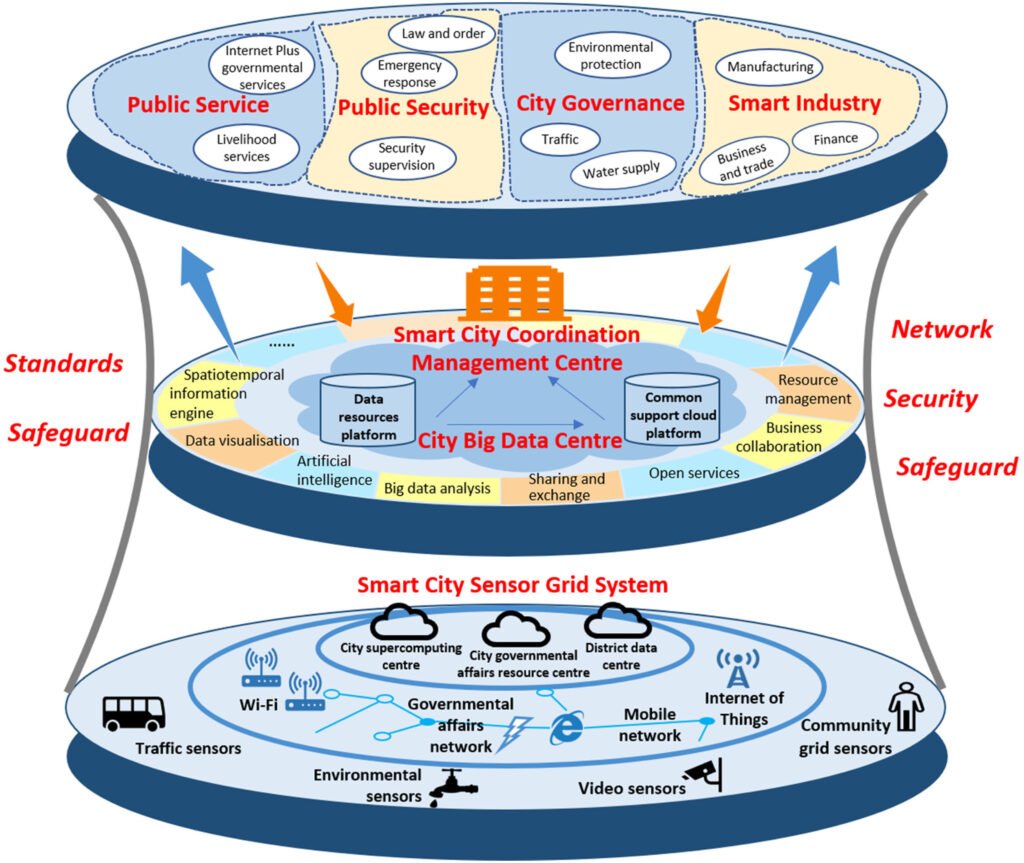
As pointed out by MIT Technology Review in 2022, there is currently no crushing, universal social credit score in China that enables totalitarian control:
There’s no evidence yet that this system has been abused for widespread social control (though it remains possible that it could be wielded to hurt individual rights).
Indeed, smart-city technology combined with SCS certainly could be wielded to socially engineer populations. The push towards smart-city developments capable of applying SCS “rules” are by no means restricted to China. It is a global governance policy agenda and the rollout of the necessary digital infrastructure is worldwide. Though most of us are yet to experience the looming overt systematic oppression, it is extremely unwise to ignore that fact that the likely digital panopticon is being erected around us.
If we accept the ongoing transformation of the places we live into smart-cities and smart-suburbs, it is the “trust” we will have placed in our rulers, whoever they may be, that is the salient issue. We will have no choice but to trust that the digital control systems we will live in are purely for our benefit. We will have to trust that the enforcement of the SCS rules will be equitable. There is currently no reason to think that will be the case.
The potential urban future that the oligarchs driving this agenda have in mind is aligned with the ambitions of the NRx technocrats. It appears that our planned smart city-state future is an envisioned tyranny.
Intergovernmental Gov-corp Technates
The global proliferation of SEZs provides plenty of enticing investment opportunities for NRx technocrats and other oligarchs (See Part 1). SEZs, however, are just one avenue for the potential location of gov-corp Technates. The global transition toward urbanization offers many more.
Ironically, the United Nations (UN) both reports on the rampant criminality common to many SEZ developments but also advocates the rapid and significant expansion of SEZs. As noted in Part 1, there is currently little or no evidence that SEZs deliver socioeconomic growth. There is considerable evidence that they seize national territory and transform it into effective private jurisdictions.
Yet, in 2022, the UN established the Global Alliance of Special Economic Zones (GASEZ) to increase the SEZ global footprint. GASEZ claims:
Special economic zones (SEZs) can make important contributions to economic growth and sustainable development. Zones can help attract investment, create jobs, boost exports, and build productive capacity. [. . .] Collectively SEZs can be more effective in modernization and policy advocacy, and bring on board stakeholders, including governments, the private sector and international organizations.
Again, there is virtually no evidence to support GASEZ’ assertions about economic growth. The reason the UN is enthusiastic about SEZ hybrid zone/city developments is that the UN considers them a more effective route for its global “policy advocacy.”
Launching GASEZ in 2022, the UN announced:
UNCTAD [United Nations Conference on Trade and Development ] joined hands with seven global, regional and national associations representing over 7,000 special economic zones (SEZs) to launch a global alliance. [. . .] They [SEZs] go by many different names, including free-trade zones and industrial parks, and are widely used by developed and developing economies. The Global Alliance of Special Economic Zones (GASEZ) seeks to drive the modernization of these zones across the world and maximize their contribution to the UN Sustainable Development Goals (SDGs). [. . .] A new model of sustainable special economic zones is therefore rapidly taking shape and they are contributing to more inclusive, resilient and sustainable economies in the countries where they operate.
The UN calls the towns and cities we live in “human settlements.” Charter Cities, SEZs with residential capacity, hybrid zone/city developments, resilient cities, 15-minute cities, etc., are all “human settlements” as far as the UN is concerned. Furthermore, all such urban renewal consistently embraces smart-city technology.
In 1977, the UN created the United Nations Human Settlements Programme (UN-Habitat) in order to promote “socially and environmentally sustainable towns and cities.” UN-Habitat states:
UN-Habitat is the focal point for all urbanization and human settlement matters within the UN system. [. . .] UN-Habitat collaborates with governments, intergovernmental, UN agencies, civil society organizations, foundations, academic institutions and the private sector to achieve enduring results in addressing the challenges of urbanization.
Urbanization is the process of the population shift from rural to urban living environments, or human settlements in the vernacular of the UN. UN-Habitat has wholeheartedly adopted the public-private partnership, or stakeholder capitalist, model of development to address “the challenges of urbanization.”
In 2018, the UN Department of Economic and Social Affairs (UN DESA) reported the findings of its research into World Urbanization Prospects:
Today, 55% of the world’s population lives in urban areas, a proportion that is expected to increase to 68% by 2050. Projections show that urbanization [. . .] combined with the overall growth of the world’s population could add another 2.5 billion people to urban areas by 2050, with close to 90% of this increase taking place in Asia and Africa. [. . .] By 2030, the world is projected to have 43 megacities with more than 10 million inhabitants, most of them in developing regions [. . .] many of them located in Asia and Africa. [. . .] As the world continues to urbanize, sustainable development depends increasingly on the successful management of urban growth, especially in low-income and lower-middle-income countries where the pace of urbanization is projected to be the fastest.
With this urbanization prospectus in mind, and with a particular focus on managing urban development in the “Global South”—an umbrella term for developing nations wherever they are located—UN-Habitat released its Strategic Plan 2020-2023:
UN-Habitat, in its role as a focal point, will call upon all development actors and stakeholders, [. . .] to work in concert to assist it in implementing its Strategic Plan. [. . .] An important effort is required to rethink engagement with the private sector to leverage investment in sustainable urbanization and to promote more appropriate models of development.
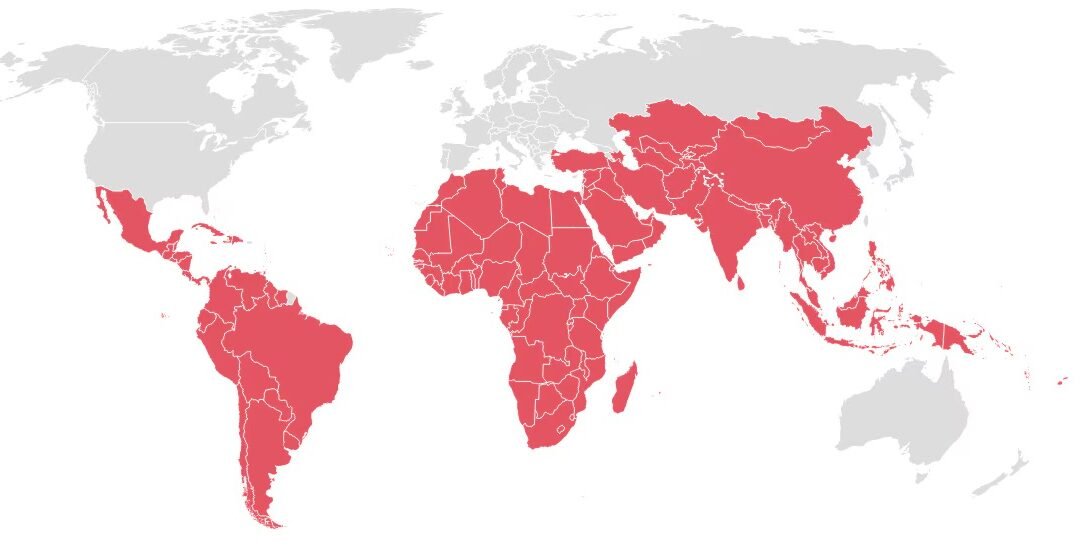
The UN is eager to liberate private finance in order to construct human smart-megacity settlements, especially in the emerging and developing markets of the Global South, that meet UN sustainable urbanization targets. Sustainable Development Goal 11—SDG 11—defines the global public-private partnership’s city development agenda.
The UN calls this its “New Urban Agenda.” The New Urban Agenda emphasises the importance of building “smart-cities” to meet SDGs:
The New Urban Agenda calls for technology and communication networks to be strengthened and for smart-city approaches that use digitalization, clean energy and technologies. [. . .] Innovative funding opportunities and partnerships need to be explored and the capacity of local governments to effectively procure, test and implement frontier technologies needs to be significantly strengthened. [. . .] To contribute effectively to urban sustainability, frontier technologies and innovations need to be applied.
The “smart-city” is constructed by deploying so-called “frontier technologies” within its infrastructure. A smart-city could be built from scratch or developed in an existing city or conurbation. The UN explains what smart-city frontier technology it considers essential for urban sustainability:
[Frontier technologies] currently include, among others, the Internet of things, sensor networks, machine-to-machine communication, robotics, artificial intelligence, virtual and augmented reality, 3D printing, geographic information systems (GIS), remote sensing, autonomous unmanned vehicles, drones, blockchain, cryptographic computing, and big data processing and visualization.
The UN’s “frontier technologies” are, of course, exactly the kind of technologies that the NRx technocrats allege to be the technological solution to everything (see Part 1). Gov-corp Technates are practically indistinguishable from the hybrid zone/city developments envisaged by the UN’s New Urban Agenda.
The downside, from humanity’s perspective, is that at both the global intergovernmental level and at the global multinational corporate-network level, there is a firm commitment to install the biometric digital surveillance state that threatens to enslave us all. Though the UN calls this “sustainable development.”
The Global Governance Patchwork
Not only is the UN amenable to the NRx technocrat’s digital panopticon plans, it also favours their “patchwork of realms” idea. The UN considers the future of global governance to lay in centralised global authority exerted over a transnational network of city-states. Or, as UN-Habitat puts it, “connectivity across urban networks, between cities and their surroundings [. . .] must be strengthened. That requires a country-wide – and sometimes cross-border – approach to development.”
The UN’s global governance model has been moving in this direction or a while. In 2005, then London Mayor Ken Livingston convened the C20 city network, inviting mayors from another eighteen cities to work collectively to reduce so-called climate pollution (CO2 emissions). In 2006, the addition of 22 city mayors created the C40 cities network.
The C40 cities network is financed by, among others, the Children’s Investment Fund Foundation (CIFF) which is heavily backed by the Gates Foundation. The aim of CIFF is to improve the lives of children living in the Global South by “lobbying” their governments to create regulatory “enabling environments” to stimulate national carbon trading in the global Emissions Trading Scheme (ETF) markets.
Another prominent C40 funder is Bloomberg Philanthropies, led by oligarch and former New York City mayor, Michael Bloomberg. Always driven by a commitment to UN global governance policies, in 2011, C40 formalised its relationship with the UN by agreeing on a climate action partnership with the World Bank—a specialized agency of the UN. Such UN partnerships are in keeping with UN ambitions to cultivate its global governance through an international network of city-states.
In 2013, American political theorist Benjamin R. Barber (1939 – 2017) published If Mayors Ruled the World: Dysfunctional Nations, Rising Cities. Barber contended that city administrations were more closely connected to their populations and thus more democratically representative than nation-states. He argued that city administrations, in countries around the world, had more in common with each other than they had with their own national governments. Unencumbered by political divisions and national rivalries, he posited that cities were better “building blocks of global governance.”
Advocating a global network of cities, Barber wrote:
If democracy is to survive globalization, imagining a global democratic order with the city at its core may be crucial. Envision not states but cities as building blocks for global governance. [. . .] Global governance in which the city predominates is the aim.
Evidently enthused by Barber’s vision, Michael Bloomberg announced he was stepping down as Mayor of New York and set up the first CityLab summit in 2013. Mayors from cities around the world were invited to network and collaborate in order to “exchange ideas and tackle some of the most urgent issues affecting cities around the world.”
In 2014, a month after officially leaving office in New York, Bloomberg was appointed as the UN’s first Special Envoy for Cities and Climate Change. Thus strengthening the link between urban development and the implementation of the global governance agenda.
UN Secretary General Ban Ki-moon said the objective of creating the post for Bloomberg was for the UN to consult “with mayors and related key stakeholders” in order to “mobilize action among cities as part of [the UN’s] long-term strategy.” Already the president of the board of the C40 cities network, Bloomberg soon established the Compact of Mayors committing city leaders to implement UN SDGs.
In 2016, the UN’s Global Compact of Mayors joined with the similar European Union’s (EU’s) Covenant of Mayors to become the Global Covenant of Mayors for Climate and Energy (GCoM). Currently acting as the UN Secretary-General’s Special Envoy on Climate Ambition and Solutions, Michael Bloomberg is the current co-chair of the GCoM.

The GCoM established the INVEST4CITIES initiative to generate “massive and targeted investment” to construct smart-cities. The private sector investment opportunity is set to provide “$23 trillion in investment potential” by 2030. The public sector’s (local government’s) role is to create “the enabling environments that support local investment.” The GCoM plan is that “large-scale financing instruments” will fund “local implementation” of frontier technologies to construct global governance (SDG) compliant smart-cities.
In the same year (2016) that the GCoM was signed by an international network of mayors, Bloomberg created the Global Parliament of Mayors (GPM) to give the civic leaders formal global governance roles. The GPM was first mooted in 2013 by Bloomberg CityLab based on Benjamin Barber’s “idea of a global governance platform for cities.” Barber was personally involved in the formation of the GPM and, when he died in 2017, the GPM created the annual Benjamin Barber Award, given to the most global governance compliant mayor of the year.
The purpose of the GPM is to attack the supposed political sovereignty of national governments and reimagine international relations. The GPM champions “the city’s right to self-government” and promotes “collective city decision-making across national borders.” The GPM is “actively engaged in decision-making by international organisations.” The GPM is the UN’s expression of Barber’s vision of “global governance in which the city predominates.”
In 2017, adopting the NRx technocrats’ accelerationism, the C40 network started implementing a number of “High-Impact Accelerators.” The C40 accelerators form one of the “project pipelines” that contributes toward the GCoM’s INVEST4CITIES strategy.
The GCoM aims to “accelerate city and local government access to financial resources” by “removing barriers to investor-oriented climate action plans and projects, and unlocking large-scale financing instruments to boost urban action implementation.” As you can imagine, with $23 trillion of investment opportunities in sight, the envisaged ROI is not only mouthwatering, if the planned city-state is a startup project it also promises oligarchs possible city ownership rights (see Part 1).
The UN Economic Commission for Europe (UNECE) convened the Day of Cities in 2019. Mayors from across, what the UN called, “the region”—meaning Europe—met to discuss “how to create smart sustainable cities.” This resulted in the 2020 Geneva Declaration of Mayors. In response to multiple alleged global crises—the pseudopandemic, the climate crisis, natural disasters, etc.—the UNECE mayors noted how the global policy response to the pseudopandemic could be adopted as a model for urban development:
[C]ities were in lockdown – and many industries, transport networks and businesses closed – we [. . .] started to experience an unknown urban life: better air quality, the return of nature to our cities, and empty streets giving space to cyclists and pedestrians. [. . .] The pandemic provided a testing ground for what cities could look like; the transformation of urban spaces happened overnight. If there is only one lesson to learn from this crisis, it is that rapid change of our urban reality is possible [and] behaviour patterns can be adapted. [. . .] Sustainable Development Goal (SDG) 11 calls for action to work towards [. . .] resilient and sustainable cities – it is now in our hands to place the SDGs at the centre of our recovery efforts and create new urban realities.
Today, boasting “over 13,500 cities and local governments” from “6 continents and 147 countries” the GCoM alleges that it represents “more than 1.2 billion people.” It is, however, hard to see how GCoM “represents” anyone other than its public-private “stakeholders.” One wonders how many people who elect their local and city “representatives” in these GCoM coordinated cities and suburbs are told that they are consenting to global governance and the transformation of their communities into smart-city gov-corp Technates.
Empty streets, no cars, drone ports, driverless AI controlled public transport, protein labs growing artificial food substitutes, augmented reality, insect-based snacks, and new religious identities are part of what leading oligarch-led think tank Chatham House (The Royal Institute of International Affairs) predicted in 2021 with its notion of our Futurescape. Whether this is the future city-life any of us want is irrelevant. At every level, NRx technocrats and their fellow oligarchs view such “urbanization” as the pathway to establishing effective global governance.
That the UN considers societal lockdowns as an exemplar of what it calls a “better urban life” betrays the oligarchs’ true intentions.

The Global Governance of Smart-Cities
The United Nations (UN) declares that it is responsible for global governance. The UN also says that “governance” means: “the process of decision-making and the process by which decisions are implemented.” Therefore, the UN asserts that it is the body which makes and implements decisions—which manifest as government policy—for the world.
UN-Habitat—the UN’s “focal point for all urbanization and human settlement matters”—with its New Urban Agenda to transform the urban environment into a global network of smart-cities, extols stakeholder capitalism and is keen to use the associated public-private partnership model. In 2022, UN-Habitat and the World Economic Forum (WEF) created the The Global Partnership for Local Investment (GPLI). The GPLI immediately set up the G20 Global smart-cities Alliance and clarified its public-private purpose:
Public-private collaborations reflect a form of indirect management in public administration, where [. . .] public, private or non-profit partners make decisions jointly. [. . .] Public-private collaborations can repurpose city assets for the deployment of digital infrastructure. [. . .] Physical assets, such as rooftops, utility poles, street lights, traffic lights, ducts and more, can become smart assets and be used to drive efficiencies and new services. Public spaces and airspace can take on new value as technology, such as drones, enabl[e] [sic] new use cases.
UN-Habitat and the WEF highlight the private sector investment opportunity for those with the wealth to capitalise on them—oligarchs:
[S]mart-city services can generate new revenue streams and revenue savings to be shared between partners.
The Futurescape imagined by Chatham House is under construction with the support of the United Nations and the “leading” multinational corporations aligned under the WEF umbrella. It is also a project shared by the BRICS+ group of nations and their corporate partners.
The BRICS have established the General Assembly of Cities and Municipalities which will focus on “inter-municipal cooperation” rather than international cooperation. Following the 2025 BRICS summit in Brazil, the BRICS group issued a joint statement:
One of the key topics shaping the future of the BRICS is the development of smart-cities supported by emerging technologies, particularly artificial intelligence (AI). [. . .] With the recent expansion of the BRICS to include countries such as Saudi Arabia, Egypt, the United Arab Emirates, Ethiopia, and Iran, the bloc is establishing itself as a leading platform for Global South cooperation [. . .] particularly in the realm of sustainable urbanization driven by technologies such as AI. [. . .] Artificial intelligence is increasingly being adopted in major BRICS cities, notably impacting urban planning, public service management, and civic engagement. China is at the forefront of developing AI-powered smart-cities, particularly in Shanghai and Shenzhen.
The BRICS+ group emphasises the importance of the BRICS New Development Bank (NDB) to “finance sustainable infrastructure” and “increase lending for AI-driven public service projects.” The group observes that “South-South cooperation through the BRICS creates active dialogue.”
The UN considers cooperation in the “South-South”—referring to partnerships between Southern hemisphere countries—“a key development modality to accelerate progress towards achieving the 2030 Agenda for Sustainable Development.” The UN Office for South-South Cooperation (UNOSSC) collaborates strategically with the Islamic Development Bank (IsDB). In turn, the IsDB has a close working partnership with the NDB. Both the IsDB and the NDB have joined seven other “Multilateral Development Banks” (MDBs) to form a global collaborative partnership coordinated by the UN’s World Bank Group:
A much scaled up global effort is thus required to [. . .] tackle transboundary [meaning cross-national border] challenges. [. . .] We [Heads of MDBs] will deepen our collaboration around joint innovative mechanisms for boosting private capital mobilization, both domestically and globally. [. . .] We recognize the need to explore further avenues for strengthening mobilization of private capital.
Regardless of where you live on the Earth, your government’s commitment to creating a global network of smart hybrid zone/cities financed by “private capital” is unshakable because your government is following a global policy agenda it did not create and cannot change.
In Vietnam, for example, the commitment to constructing smart-cities is significant. Vietnam’s state media, The Voice of Vietnam (VoV), reports:
Vietnam is undergoing a sweeping transformation with a clear goal: to build smart-cities that serve the people. The effort is based on national strategies like the Sustainable smart-city Development Plan 2018-2025 with a vision to 2030, the National Digital Transformation Program until 2025 with a vision to 2030, the E-Government Development Strategy toward a Digital Government, and Project 06 on population data and digital identity.
The VoV states that residents in smart-cities can “report issues directly to authorities, who respond and take corrective action.” Vietnamese digital smart-city citizens can raise concerns relating to “public security[,] environmental management, healthcare, [. . .] education,” and more via their installed smart-city app. The VoV enthusiastically notes that centrally located AI monitored Intelligent Operations Centers (IOCs)—Urban or City Brains—linked to peoples’ devices and their Vietnam Electronic Identification (VNeID), issued by Vietnam’s Ministry of Public Security (MPS), effectively turn the Vietnamese smart-city citizens’ “smartphones into ‘microphones.’”
The VoV adds:
Citizens must also play their part: verifying VNeID at level 2, uploading personal documents to their digital accounts, using the national portal [. . .] for public services, downloading their local smart-city app, and using cashless payments wherever possible. Every tap on a screen lays another brick in building Vietnam’s vision of modern, intelligent, liveable cities for the future.
The state taking almost unimaginable control of every “citizen’s” life is part of Vietnam’s digital transformation plan—Project 06. The Vietnamese government has already started the process of freezing up to 86 million of Vietnam’s estimated 200 million banks accounts unless they are “verified” using state approved digital ID (biometric authentication or VNeID). So clearly, every citizen “must” comply and the digital transformation, despite all the fluffy rhetoric about inclusion, is avowedly exclusionary.
Project 06 is led by the State Bank of Vietnam (SBV) working closely with the Ministry of Public Security (MPS). A major part of the role of the MPS is to ensure social order and to collect, analyse and evaluate information with a view to “prevent, detect and defeat any plots and acts of violation against national security and eliminate any threats to national security,” to protect the “Party” and the “State,” and to “implement international commitments and obligations.”
The digital surveillance plan has been promoted by Prime Minister Pham Minh Chinh and other government officials, but the Project 06 policy initiative did not originate with the Vietnamese government. With its stated “vision to 2030,” Project 06 is firmly rooted in the United Nations’ (UN’s) global governance agenda.
The Vietnamese Ministry of Planning and Development noted that the country’s digital transformation will contribute to the reduction of (CO2) emissions, though it is obviously designed to enable state surveillance of the population. Speaking in January this year, UN Under-Secretary-General Amandeep Singh Gill said he was impressed with Vietnam’s public-private partnership (multistakeholder) approach to “harness digital technologies for inclusive, sustainable development.”
He added:
I saw with my own eyes how Viet Nam is pushing forward strongly and proactively in the areas of digital transformation and AI. [. . .] [F]rameworks are needed to ensure that everyone benefits from the technical advancement, and that no one is left behind. [. . .] The Global Digital Compact offers such a framework at the global level, and Viet Nam’s willingness to play an active role in key areas of the [sic] is welcomed and appreciated by the United Nations.
The Global Digital Compact, adopted without a vote in September 2024 by UN member states as an annex to the UN’s Pact for the Future, is the UN’s “global framework” to facilitate “multi-stakeholder action” to enable “the attainment of the Sustainable Development Goals.” The UN defined “digital public goods” as software, data, AI models, and all content published online. Further, it decided that “digital public infrastructure” essentially meant all hardware and the physical infrastructure for all digital communication systems.
The UN said that it considered “digital public goods and digital public infrastructure to be key drivers of inclusive digital transformation and innovation.” It added that “[g]overnments, the private sector, civil society, technical and academic communities and international and regional organizations” should work together to to “leverage digital public goods and digital public infrastructure to advance solutions for the Sustainable Development Goals.”
In other words, the UN decided that the internet and digital technology, in its entirety, should be leveraged to deliver the UN’s global governance policy agendas. The UN invited the “private sector and philanthropic actors [oligarchs]” to finance the digital transformation.
Populations might not want to go along with the digital transformation of their world, nor the degree of public-private state surveillance foisted upon them. Perhaps anticipating some pushback, the UN decided that anything that questioned its transformative global governance agenda constituted a “form of violence” it calls “misinformation and disinformation”:
We must urgently counter and address all forms of violence, including [. . .] all forms of hate speech and discrimination, misinformation and disinformation. [. . .] We commit to, by 2030, [. . .] assess the impact of misinformation and disinformation on the achievement of the Sustainable Development Goals. [. . .] We further urgently [. . .] [c]all on social media platforms to provide researchers access to data [. . .] to build an evidence base on how to address misinformation and disinformation and hate speech that can inform government and industry policies, standards and best practices
The idea that governments and private corporations should form “policies” to address “misinformation and disinformation” might sound reasonable at first, but that all depends upon who decides what constitutes misinformation and disinformation. The UN is clear that misinformation and disinformation incudes information that undermines its policies related to “public health and climate action.”
Questioning the global digital transformation that is designed to “advance solutions for the Sustainable Development Goals” threatens “climate action” and is therefore disinformation that governments and private corporations should “counter and address.” Governments around the world are implementing laws and regulations to seize control of the information we can share with that goal in mind.
Of course, this could not be more anti-democratic, but governments serve as functional oligarchies not democracies. None of the governments that have passed or intend to pass online censorship laws are the instigators of these policies or legislative moves. They emanate from the global governance of the UN and its agencies where real Orbital Authority is exercised.
Real Orbital Authority
In Part 1, we discussed NRx technocrat Curtis Yarvin’s metaphorical exploration of global government that he termed “Orbital Authority.” The global transformation of our urban environments is already being propelled by such authority.
It is an oligarch-led public-private, or multistakeholder, global governance authority. Oligarch-backed policy think tanks, such as Bloomberg’s CityLab, and the state-funded public-private partnership think tanks, like the China Academy of Information and Communications Technology (CAICT), form the policy and design the corresponding implementation initiatives.
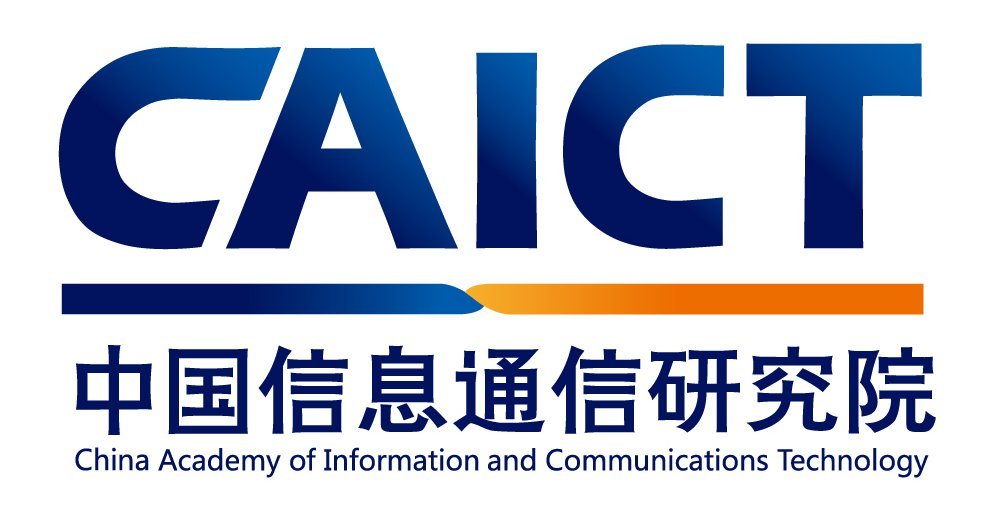
The CAICT calls itself “a specialized think-tank for the government and an innovation and development platform for the industry.” The CAICT acts as an “enabler for innovation and development in an information society.” It is a public-private partnership that “plays an important role in strategy and policy” with respect to the digital transformation in China.
Chinese state media recently reported China’s official launch of its plan to provide “processing resources across China,” to link City Brains and other smart-city elements together in a “mega computing project” that will create regional data hubs. From the reports, you would imagine that the CPC was leading the rollout. That impression is misleading. It was the CAICT that proposed the concept of the “National Integrated Computing Power and Network Scheduling Platform” that has given rise to the reportedly state-led mega computing project.
The CAICT is also a UN partner with an agreement in place to implement the “digital transformation aligned with the Sustainable Development Goals” across Africa. African governments are not designing “Africa’s digital future” any more than China’s government is heading the “digital transformation” in China. The transformation is a global governance agenda, far beyond the influence of any electorate or population, and national governments’ role is merely to create the enabling environment (see Part 1) to establish the resultant global governance.
The UN fully backs and promotes this worldwide digital transformation. In addition, the UN has already established global governance structures “in which the city predominates.” This unwavering transformation of the global polity and societal norms is precisely what the NRx technocrats want and are committed to achieving. The Orbital Authority that Curtis Yarvin deems necessary for “thousands of independent sovereign states and city-states” to “flourish” is being constructed by the UN and its multinational corporate “stakeholders.”
The UN is predominantly an oligarch-led project. In 2014, professor of international history Ludovic Tournès, writing for The Journal of Modern European History, highlighted the significant influence of the Rockefellers in establishing the United Nations. In the late 1950s, the Rockefeller-funded Special Studies Project began publishing its findings, culminating in the 1961 publication of the full report titled “Prospect for America: The Rockefeller Panel Reports.”
Seeking to strengthen UN global governance, The Rockefeller Study Project recommended dividing the world “into smaller units” that would “consist of regional institutions under an international body of growing authority [the UN]” (page 26). The researchers ultimately recommended:
The most natural multination arrangements are frequently regional. [. . .] We believe that this regional approach has world-wide validity. [. . .] What is needed immediately is a determination to move in the direction they imply. Regional arrangements are no longer a matter of choice. They are imposed by the requirements of technology, science, and economics. Our course is to contribute to this process by constructive action [pages 188–190].
The idea of a global governance system, based upon a regional balance of power, had been pursued by a trans-Atlantic oligarch network—of which the Rockefellers are leading members—since the early 20th century. As part of the process of “constructive action” to establish this new world order, in 1965 the Rockefellers convened an international conference at their Villa Serbelloni mansion in Bellagio, Italy. Today called the Bellagio Center, the 1965 meeting at the Villa set up the Club of Rome policy think tank which solidified as “a core group of like-minded thinkers” in 1968.
In September 1973, the Club of Rome proposed a global governance model that divided the world into ten regions. In their report, titled “Regionalized and Adaptive Model of the Global World System,” they described these global governance regions as “Kingdoms.”

The same year, David Rockefeller co-founded the Trilateral Commission policy think tank with US political scientist and policy advisor Zbigniew Brzezinski. Unsurprisingly, the Trilateral Commission claims the authority to “affect [. . .] foreign policy and national security strategies,” across three global regions it calls pillars: North America, Europe, and Asia Pacific. The current model of regional Kingdoms—“pillars” or “poles”—is commonly referred to as multipolarity and the consequent Multipolar World Order (MWO) is said to be in prospect.
The Munich Security Conference (MSC) is the premier international public-private security policy conference where predominantly, but not exclusively, Western “decision-makers” meet annually to network and form international defence and security policy. The MSC 2025 report informs us that there is a “changing global distribution of power,” adding that a “multipolar world holds significant promise.” However, it also notes that the new multipolar global governance bureaucracy must not impede “joint approaches to global crises and threats.”
The MSC determined that “depolarization [. . .] could set multipolarity on a positive track,” where “depolarization” refers to the process of nations accepting their sociopolitical and perhaps cultural differences but aligning to their respective “poles” in order to address “global crises” through collective action. To explain its “depolarization” point, on behalf of the MSC “decision-makers” it represents, the MSC report referenced the 2023 comments of then German Chancellor Olaf Scholtz who said, in order to “keep multilateralism alive in a multipolar world,” it was essential to maintain “greater participation in, and integration into, the international order.” In other words, depolarization is multipolar decentralisation leading to greater centralisation within the global “order.”
This is the same decentralization to recentralization trick (see Part 1) favoured by the NRx technocrats. Depolarization is not transforming global governance by chance. Influential oligarch-led policy think tanks, such as the UK-based Chatham House and its sister organisation, the US Council on Foreign Relations (CFR), have been trying to create the depolarized regional balance of power global governance system for more than a century.
The Council on Foreign Relations is among the many Western oligarch-led think tanks to have consistently promoted multipolarity. In 2023, a team of CFR analysts expressed their opinion about what would constitute the perfect “pole” in a Multipolar World Order:
The EU [European Union] is a networked union that allows its members to act together in some ways and apart in others. The EU [. . .] has far more power over its members, which remain sovereign states, than any other regional entity. It is one of a kind. [. . .] The EU has developed a template that other regional organizations are following and customizing in various ways. [. . .] Foreign policy practitioners should hope these blocs succeed. Powerful regional unions are the necessary intermediaries between international or global institutions and state and local governments.
According to the CFR, the European Union (EU) presents us with the ideal “template” for a MWO pole. Speaking at the 2025 Munich Security Conference, H.E. Wang Yi, Director of the CPC’s Committee Foreign Affairs, stressed that “China has always seen in Europe an important pole in the multipolar world.” China is currently leading the push to create an Asian Union. The CPC and the CFR appear to be in agreement on the perfect “pole.”
Though nation-states supposedly remain “sovereign,” the EU-pole exerts “power over its members”—constituent governments. This CFR argument is self-contradictory nonsense. The governments of nation-states cannot possibly be both “sovereign” and, at the same time, subservient to the leadership of their “pole.” It is unconscionable to imagine that the CFR analysts don’t appreciate this point. What they offer is MWO propaganda.
The whole point of the regional “pole,” or “union,” is to act as a completely unnecessary “intermediar[y] between international or global institutions and [. . .] governments.” The CFR defines “international or global institutions” as the UN, its specialized agencies, and groups like the International Monetary Fund and the the G20 (Group of Twenty).
We have just discussed the G20 Global smart-city Alliance. It embraces stakeholder capitalism, where governments and their private sector partners “make decisions jointly [to] repurpose city assets for the deployment of digital infrastructure.” Given the UN commitment to global governance where “the city predominates,” the discernable nature of the real “Orbital Authority” is materializing.
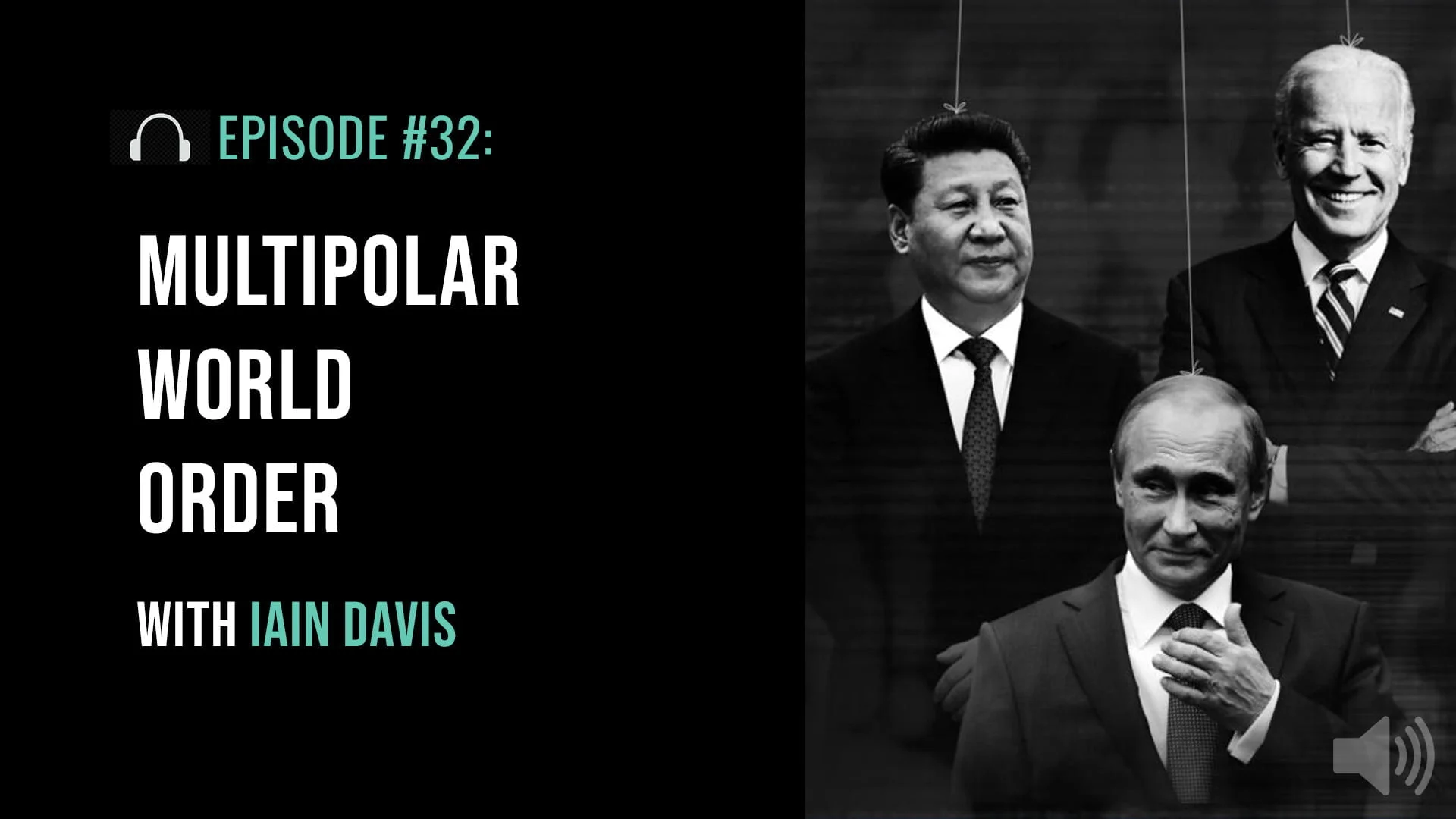
Governments that are functional oligarchies (see Part 1) are being subsumed into regional poles within a Multipolar World Order that has been actively sought by generations of globalist oligarchs. The poles will empower public-private “international organisations”—dominated by private capital (oligarchs)—to set policy for the regional pole’s member state, thereby removing any meaningful expression of national sovereignty. Simultaneously, privately financed smart-city “zones” are being carved out of nation-states as global governance moves toward “collective city decision-making across national borders.”
Curtis Yarvin’s “Orbital Authority” was a metaphor, but there is nothing metaphorical about the deliberate, oligarch-led transformation of our world. What they are constructing mirrors the “patchwork” of network states—gov-corp Technates—proposed by the NRx technocrats. The aim is the digital enslavement of humanity to the asserted authority of private capital. Far from resisting this emerging tyranny, governments are willingly hastening the process because they are functional oligarchies.
Knowing the kind of feudalistic tyranny they portend, who would ever choose to live in a gov-corp Technate? Unfortunately, millions of the most vulnerable people on earth don’t have much choice regarding where they live and architects of the gov-corp Technates are targetting them to be among their first “customers.”
Orbital Authority Over Refugees
In 2025, the UN High Commission for Refugees (UNHCR) reported that refugee migration in 2024 was “driven by conflict, persecution, human rights violations, and instability.” Refugees fled man-made war zones, man-made economic destruction, and man-made persecution—overwhelmingly from countries in the co-called Global South—but there is no sign of people fleeing any climate crisis, anthropogenic or otherwise.
Of course, people have to escape natural disasters such as floods and forest fires. But there is no evidence of any upward trend in either the frequency or severity of weather related natural disasters. Again, all too often, we find that the lethal scale of, for example, catastrophic flooding, though undoubtedly caused by extreme weather events, is exacerbated by very poor planning decisions. Nevertheless, as the UNHCR reports, climate change is not a driver of mass migration.
Yet, the UN and its partners constantly refer to refugees as largely escaping the “climate crisis.” As there are no climate refugees, the core PR message to the contrary is designed to supposedly justify and facilitate the global governance agenda— the Sustainable Development Goals (SDGs). That there is no evidence of any climate crisis is irrelevant. Our collective belief in the propaganda is all that matters.
Back in 2018, shortly before the UN adopted the Global Compact on Migration, at the annual UN convened Mayoral Forum on Human Mobility, Migration and Development, civic leaders from eighty cities formed the UN’s Mayors Migration Council (MMC). The MMC is a sponsored project of Rockefeller Philanthropy Advisors that aims to make “a tangible difference in the lives of urban migrants, displaced people, and receiving communities worldwide.” It further proclaims that it “accelerates ambitious global action on migration and displacement to create a world where urban migrants, displaced people, and receiving communities can thrive.”
NRx technocrat accelerationism (see Part 1) is now enmeshed in all levels of global governance. Rockefeller Philanthropy Advisors openly declares that its “mission is to accelerate philanthropy in pursuit of a just world by providing deep global expertise.” It is easy to imagine that the ubiquitous use of the term “accelerate,” or variations thereof, is just a reflection of in vogue terminology, but it is omnipresent and we would be naive to overlook its ideological significance.
The UN outlines its purpose in its associated Global Compact:
Our Ambition is to: Accelerate and scale the global collective impact of business by [. . .] delivering the SDGs through accountable companies and ecosystems that enable change.
To this end, the UN adds:
The United Nations Global Compact is leading Accelerators to embed SDG-aligned practices deep into business operations and across the value chain to accelerate progress and impact for the 2030 Agenda. Available to participating companies of the UN Global Compact, the Accelerators are run in close collaboration with Global Compact Country Networks and are designed with a view to generating behavior change across a large number of companies at the local level – achieving maximum impact and scale.
The UN’s Global Compact is a supposedly “non-binding” policy agenda, first adopted by the United Nations in 2000. The Compact is not focused on intergovernmental cooperation and has virtually nothing to do with nation-states. The UN describes it as “the world’s largest corporate sustainability project.”
Agenda 21 is also a non-binding “plan of action” that, in 1992, laid the foundations for the global sustainable development. The Agenda 21 global policy agenda has shaped the lives of nearly everyone on earth in subsequent years. The UN coordinates policy globally and calling its policy agendas “non-binding” is meaningless if the public sector and the private sector rigidly adhere to them.
The UN is determined to create “global governance in which the city predominates.” Consequently, the MMC has been empowered by the UN to “influence policy decisions at the national and international level.” As NRx technocrat accelerationism pervades pretty much everything the UN does, the MMC says that it “accelerates global action on migration and displacement.”
The MMC has established task forces with other city-state networks, C40 for example, to manage the migration caused by the climate crisis, irrespective of the fact that the UN concedes there are no climate refugees. In addition, as far as the MMC is concerned, international relations based on Westphalian sovereignty is a “broken system” and it has therefore created the financial pathway for investors to directly fund city-state plans for refugees.
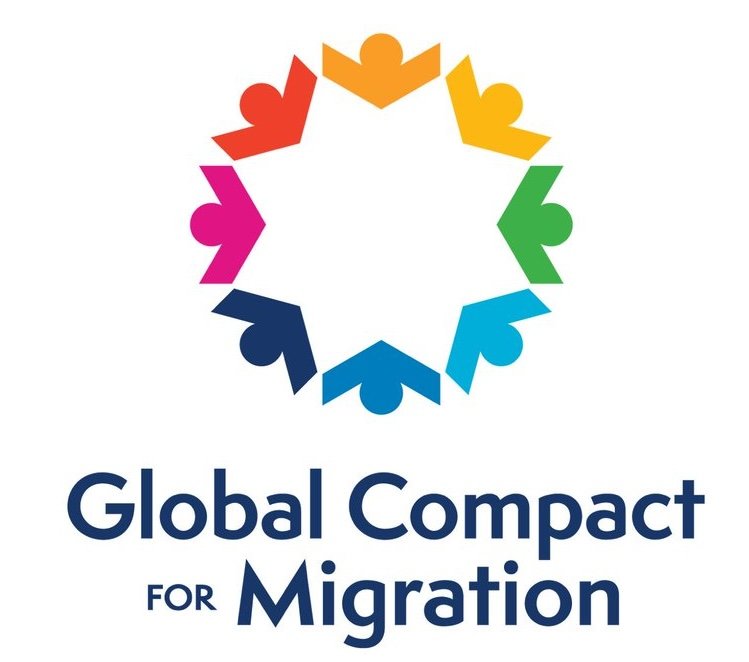
The MMC’s Global Cities Fund for Migrants and Refugees is set to transform the broken system by directly funding city-states. The Cities Fund offers international donors an investment “pipeline” to circumvent national governments and directly channel “international resources to city governments.” This is to enable “city governments and their local partners to implement projects of their own design.”
The focus of the investment is to support “city governments” to manage “their migrant and displaced communities.” The investment pipeline will create a “a marketplace of city-led solutions” and the reason for all of this is to ensure the UN’s “Global Compacts for Migration” is implemented.
The UN claims that its Global Compact on Migration (GCM) is grounded in the “values of state sovereignty.” As we have just discussed, there is scant evidence of that. Instead, the Global Compact seeks to apply a “common approach to international migration in all its dimensions.”
Those dimensions are encapsulated in the twenty-three GCM Objectives. The first Objective is to harvest as much data as possible from refugees and economic migrants. The third is to develop systems for the sharing of that data with stakeholders. This accompanies Objective 4, which seeks to force “all migrants [to] have proof of legal identity,” by which the UN means digital ID. At the city or “municipal” level, the UN wants to use migrants to implement digital ID as a means of exclusion:
Build upon existing practices at the local level that facilitate participation in community life, such as interaction with authorities and access to relevant services, through the issuance of registration cards to all persons living in a municipality, including migrants, that contain basic personal information.
That is to say, everyone’s “participation in community life” and everyone’s access to services will be contingent on you having a UN-approved, compatible digital ID.
As we have repeatedlydiscussed, the UN’s own research clearly shows that there is no climate crisis-related immigration. Objective 2 is focused upon “minimising the drivers” of migration flows but identifies virtually none but the alleged migration impacts of the so-called climate crisis.
Of the twelve clauses to Objective 2, just one briefly mentions “conflict” but only to the extent of “taking into consideration relevant recommendations from State-led consultative processes, such as the Guidelines to Protect Migrants in Countries Experiencing Conflict.” Despite knowing full well that people have to flee from war, persecution, and poverty, not climate change, the UN’s GCM, supposedly designed to assist the dispossessed and the most vulnerable refugees, has practically nothing to say about tackling any of the actual underlying causes of their plight.
Even objective 7, to “reduce vulnerabilities in migration,” says nothing about persecution, impoverishment, or conflict. Instead it insists upon providing refugees with “identification,” presumably because humanitarian assistance simply cannot be provided otherwise. Refugee children should be added to national identity systems and “stakeholders” should be fully engaged in the child’s identification process.
The unmistakable purpose of the UN’s GCM “Objectives” is to exploit immigration to cement the UN’s global governance agenda. This is starkly highlighted by “Objective 19: Create conditions for migrants and diasporas to fully contribute to sustainable development in all countries.”
The UN wants to “harness the benefits of migration as a source of sustainable development.” The main goal is to:
Ensure the full and effective implementation of the 2030 Agenda for Sustainable Development [. . .] by fostering and facilitating the positive effects of migration for the realization of all Sustainable Development Goals
The UN’s marked lack of any genuine concern for the predicament of refugees is bad enough but, when we then consider who it chooses as its “partners” to assist with its planned migration, the reality that dawns is stomach churning.
Refugee Gov-Corp Technates
Titus Gebel is the former Chairman of the Board of the Patri Friedman’s Seasteading Institute—a joint project between Peter Thiel and Friedman—and a partner at NeWay Capital. He is the founder of Tipolis Inc and a leading investor in and legal advisor to Próspera, having previously acted as a legal advisor for the Honduran government’s original ZEDE program (see Part 1).
In 2018, Gebel published Free Private Cities: Making Governments Compete For You. His book outlines how private corporations—i.e. Yarvin’s sovcorps—can provide “government as a service.” He suggested that customers should sign a contract in return for the governance they receive from their sovcorp. Governance providers, in various city-states, would compete for customers (citizens) who would be free to leave, subject to contract, if they didn’t like the private government service on offer in their zone (gov-corp Technate).
It seems Gebel essentially plagiarised the NRx technocrat’s ideas, first put forward by Curtis Yarvin and Nick Land about a decade before Gebel took credit for his supposedly “completely new” gov-corp Technate model. Clearly an NRx technocrat, Gebel established Tripolis Inc—in the tax haven of Singapore—in order to create new models of innovative governance. Via Tripolis Inc, Gebel, and his coterie of angel investor partners, hope to become the “owner[s] and operator[s]” of their own International Cities:
International Cities are privately run communities, based on clear contracts, which provide, enable and facilitate opportunity and choice. International Cities will be established at multiple locations around the world. [. . .] International Cities build on the concept of Special Administrative Regions (SARs) and are the next evolution of Special Economic Zones (SEZs). [. . .] International Cities will be thriving hubs of business and innovation.
Special Administrative Regions (SARs) were formulated by the Chinese government under Deng Xiaoping as part of its “one country, two systems” policy. Hong Kong, Macau and Taiwan were legally designated SARs by the Chinese government in the early 1980s. The intention was to provide regulatory autonomy to hopefully reunified territories, though Taiwan has yet to commit to reunification. That Gebel considers the larger SARs as “the next evolution” of SEZs speaks to the territorial ambitions of those pursuing the city-state agenda.
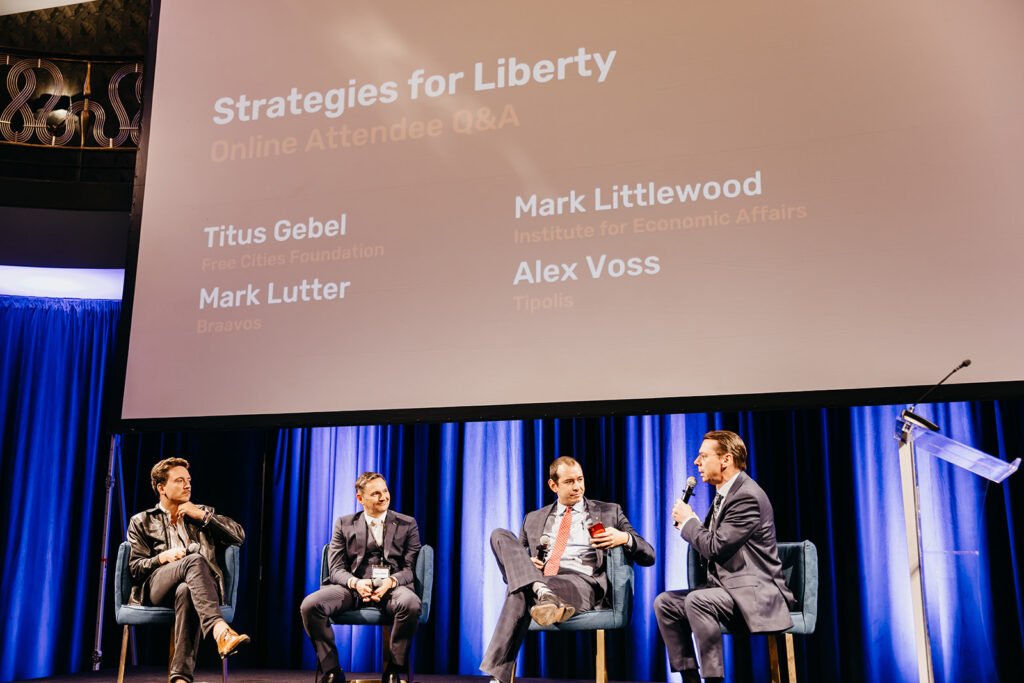
Gebel is also an advisor to the Swiss-based Andan Foundation led by its founder Dr Christian H. Kälin (or Kaelin). The Andan Foundations explains its purpose:
Andan leads private sector initiatives to support families fleeing their homes due to war, internal conflict, and climate change. It identifies and develops innovative, sustainable solutions. [. . .] Andan prioritizes projects that expand economic, financial, and political opportunities for both refugee populations and the communities that welcome them. Andan facilitates and propels partnerships between the private sector and UN agencies, governments, NGOs, and academic institutions concerned with refugees and migrants.
Andan proposes a business that capitalises on the “opportunities” presented by refugees, asylum seekers and economic migrants. The Foundation adds that its “main, long-term project is the Andan Free Global City project—or “International City” as Gebel would call it—which it says has the potential to “completely upend and reform how we deal with the growing global refugee and migration crisis”:
Today, the world is spending billions of dollars each year in dead-end, protracted refugee management with camps and urban settings. [. . .] We aim at no less than completely turn around the way we look at refugees and migrants. [. . .] What we need is again a safe harbour, a new place where refugees and other migrants forced to leave their homes receive the opportunity to live. [. . .] We need free Global Cities – autonomous, self-governed subnational entities that provide a safe environment. [. . .] We are also actively engaged with several governments around the world, as well as with a few major investors who are prepared to finance the establishment of the first free Global City, which will also provide a decent return on capital from private investors.
Kälin, an advisor to the Swiss government among others, suggests reading a 2022 article by Albert Steck to really get a feel for what he, Gebel and other international NRx technocrats are proposing:
[Kälin] sees his Andan Global City not only as a humanitarian project, but also as a profitable business idea. [. . .] In Kälin’s city [refugees] would be motivated workers and founders of businesses. [. . .] [Kälin is] in talks with representatives of the U.N. and the World Economic Forum. [. . .] The biggest challenge is finding a country that will provide an uninhabited or sparsely populated territory for an autonomous city, he says. [. . .] Initially, several tens of thousands of people could live there – with the prospect that it might ultimately become a city of millions. Private financing is therefore crucial to the success of such a large project, says entrepreneur Titus Gebel. [. . .] Gebel, who was born in Germany, is also the founder of the Free Cities Foundation, which works to establish special economic zones in various countries, following the example of Shenzhen in China or the European free cities in the Middle Ages.
Like all NRx technocrat fronts, the Andan Foundation staunchly advocates digital ID and suggests that blockchain “has the potential to create new solutions for refugee and identification systems” and that digital ID, stored on a unified ledger, should be “directly accessible to refugees and immigrants.” Once the refugee’s digital twin is operational, the refugees can serve as “motivated workers” in the Free Global City—gov-corp Technate. Presumably, should they be insufficiently motivated, their access to money and food “could be frozen” and they could be “locked out of all doors” to essential services until they rediscover the correct motivation.
Christian Kälin is also the Chairman of Henley & Partners, a UK based consultancy that specialises in a lucrative venture which Kälin claims to have “pioneered.” Henley & Partners touts itself as “the world’s foremost experts in investment migration and citizenship-by-investment.”
Serving a clientele of “internationally mobile entrepreneurs and investors,” Henley & Partners (H&P) says that it helps “high-net-worth and ultra-high-net-worth individuals” to obtain “bespoke residence and citizenship by investment.” Essentially, Kälin and H&P advises “ultra-high-net-worth individuals”—including oligarchs—where to invest in order to buy residency visas and citizenship and then manages the application process for them.
The history of “citizenship-by-investment” (CBI) schemes is not very edifying. For example, Paolo Zampolli, President Trump’s global envoy for special partnerships, was evidently involved in a seemingly corrupt CBI scheme that sold Dominican Republic residency to Chinese billionaires, such as Ng Lap Seng, who were under investigation by the UN for bribing UN officials. John Ashe, the former president of the UN General Assembly, was also suspected of involvement but died in an extremely bizarre bar-bell “accident” shortly before he was due to testify in the case.

Kälin has been dubbed the “Passport King” for his pioneering efforts in the CBI field. However, according to US-based Organized Crime and Corruption Reporting Project (OCCRP), H&P has been involved in numerous corrupt CBI schemes. For instance, in the Caribbean nation of the Federation of Saint Kitts and Nevis between 2006 and 2013.
The St. Kitts and Nevis Sugar Industry Diversification Foundation (SIDF) was “set up in 2006 to move the island economy away from dependence on sugar.” The SIDF turned agricultural land into development land. The purchase of territory was funded by the government and H&P’s “high-net-worth” clients seeking residency in St. Kitts and Nevis, many of whom had criminal ties or were wanted in various jurisdictions.
Money from the SIDF fund was then directed to invest in companies that Kälin was closely associated with. H&P insisted there was no conflict of interest. The SIDF became inoperative around 2017 and, with important agricultural land lost and no sign of any return on the government’s SIDF investment, the OCCRP noted that the “ultimate losers were the people of St. Kitts and Nevis.”
Kälin was seemingly the financier behind the Strategic Communications Laboratories Group’s (SCL’s) 2010 re-election campaign for then St. Kitts and Nevis Prime Minister Denzil Douglas. In 2018, an interim UK parliamentary investigatory report issued by the powerful Digital, Media, Culture and Sports Committee (DMCSC) noted:
211. We were told, behind much of SCL Elections’ campaigning work was the hidden hand of Christian Kalin, Chairman of Henley and Partners, who arranged for investors to supply the funding to pay for campaigns, and then organised SCL to write their manifesto and oversee the whole campaign process. In exchange [. . .] Henley and Partners would gain exclusive passport rights for that country, under a citizenship-by-investment (CBI) programme.[. . .] Christian Kalin [has] been described as having a ‘Faustian pact’. With the exclusive passport rights came a government that would be conducive to Mr. Kalin and his clients.
The British defence contractor SCL is the parent company of the notorious Cambridge Analytica (CA)that was widely accused of manipulating the 2016 US presidential elections and the UK “BREXIT” referendum on leaving the European Union (EU). The CA operation also illegitimately acquired the data of millions of Facebook users. Hence, the UK parliamentary investigation.
CA, and thus SCL, is evidently connected to Peter Thiel’s Palantir. As CA’s suspected election manipulation, and what was tantamount to data theft, came under international scrutiny, Palantir disavowed that connection. But, when the New York Times revealed that one of its employees—Palantir business manager Alfredas Chmieliauskas—had worked with CA to form “behavioural profiles” of voting social media users, Palantir changed its statement and said Mr Chmieliauskas was not acting on Palantir’s behalf at the time, though he was a Palantir employee throughout the period.
H&P’s CBI schemes were not limited to the Caribbean. They have reportedly been found to be wholly corrupt in Cyprus, for instance. When, in 2017, Maltese investigative journalist Daphne Caruana Galizia started to expose H&B’s involvement in Malta’s corrupt Individual Investor Programme (IIP)—Malta’s CBI scheme—subsequent inquiry hearings revealed emails indicating that H&P instigated a Strategic Lawsuits against Public Participation (SLAPP) against her. It seems H&P intended to file the lawsuit in the UK because they wanted a “sympathetic judge.” Daphne Caruana Galizia, who was also instrumental in reporting the Panama Papers, was assassinated in a car bombing in Malta in October 2017.
More recently, the European Court of Justice (ECJ) has ruled the Maltese CBI scheme illegal. As an EU member state, a Maltese passport provided some questionable “ultra-high-income individuals” with EU citizenship. It is not without justification that the ECJ characterised CBI schemes, including those run by H&B, as making “the acquisition of nationality a mere commercial transaction.”
Kälin, who conceded that some H&B clients were “problem[s]” who fell through H&B’s claimed “due diligence” checks, was undeterred by the ECJ ruling. He was enthused by the global expansion of CBI schemes and, in particular, the Trump administration’s plan to issue permanent residency visas to anyone who can afford the $5 million price tag. If he wants to move to the US, Kälin could certainly afford a US “gold card.”
Fours years earlier, In 2021, numerous hedge funds faced potential ruin as a result of the GameStop short squeeze. When Reddit users noticed the mass shorting of stock in the the GameStop chain of high-street stores, they apparently spiked demand for the stock and pushed the price up by coordinating large-scale stock purchases. Thus leaving those with short positions—betting the stock price would fall—exposed to enormous losses. Through his company Arnova Capital, Christian Kälin consequently made a fortune on the GameStop stock his company held. He also accurately predicted, before any WHO announcement of a worldwide pandemic, that energy prices would soar during the pseudopandemic. Kälin’s 2000% ROI on his initial investment in Arnova Capital is truly remarkable.
The Andan Foundation, founded by Kälin and advised by Gebel, that seeks to profit from refugee migration by establishing Free Global Cities, is a “long-standing” partner of the United Nations. The goal of the partnership is to “propel and facilitate the private sector’s involvement,” in managing international refugee migration with a view to create “public and private initiatives that create long-term solutions for refugees.”
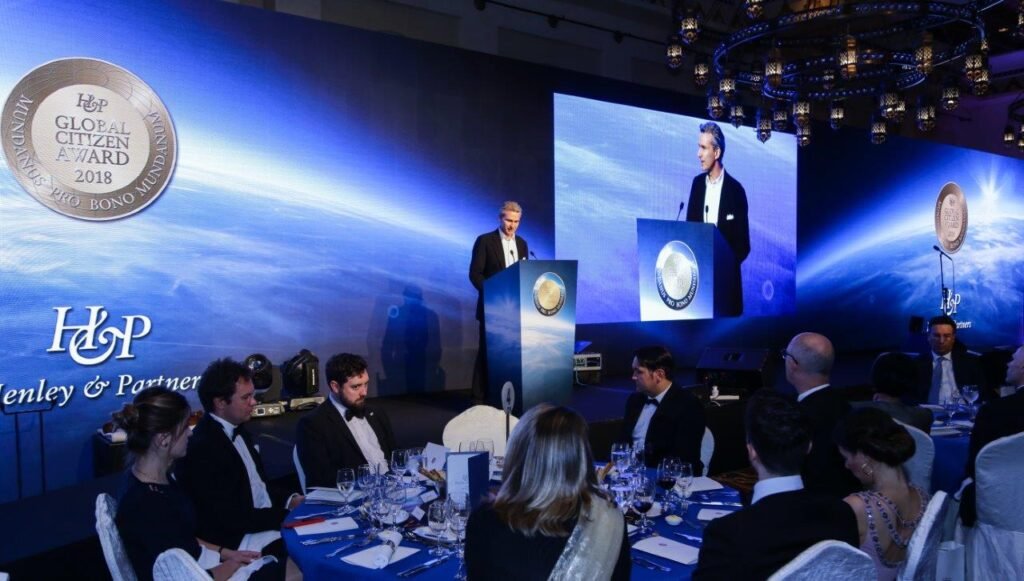
The appalling stench of neocolonialism exudes from every part of the UN’s global migration policy agenda. The oligarch-led UN public-private partnership is implementing a strategy that aims to exploit migrants and refugees to achieve UN objectives. There is no serious attempt to do anything to address the problems that cause mass migration. The migrant is simply a “human resource” to be identified, stamped and relocated into communities the world over in order to achieve UN policy targets.
The UN wants to construct a global network smart-city gov-corp Technates because that too will better facilitate the rollout of its global governance; it has formed partnerships with NRx technocrats who want to use the displaced as a workforce and who view refugee “residency” in their gov-corp Technates as a “profitable business idea;” the UN is supporting and encouraging the national governments to hand over territory to oligarch investors in preparation for its New Urban Agenda, and the UN wants all lives, including those of refugees and economic migrants, to be controlled by digital technology linked to the digital ID of their digital twin.
The networks, technological systems, and investment “pipelines” are in place to enable gov-corp Technate ultra-high-net-worth “founders” to buy citizenship, should they wish, and set up gov-corp Technates either by investing in SEZs or smart-city developments already underway. In 2024, the UNHCR estimated that there were 123.2 million displaced people seeking refuge. Clearly, NRx technocrats like Titus Gebel and Christian Kälin hope to provide said refuge for a profitable return.
Gov-corp Technates in the United States
In 2023, on the US election campaign trail, calling it a “quantum leap,” Donald Trump proposed initially constructing ten “Freedom Cities” in the US. As reported by Bloomberg:
The end game is audacious: High-tech company towns free from state law and most federal rules—including the Internal Revenue Code, major environmental laws like the Clean Water Act and the Endangered Species Act; worker protections like the Fair Labor Standards Act and the Occupational Health and Safety Act; and the Affordable Care Act.
There are currently around 300 SEZs in the US and the potential for expansion of the Freedom City concept in the US is already marked. The Freedom City idea, though it provides the same SEZ regulatory advantages to multinational corporations, stands apart somewhat from other SEZ initiatives. The Freedom Cities will be constructed on parcels of US territory sold-off directly to private investors.
Initially, the Trump administration tried to sell-off US territory to oligarchs through public land sale provisions included in Trump’s One Big Beautiful Bill. Due to public and political opposition, the public land sale clauses were removed prior to the Bill passing. The NRx technocrats behind the Trump administration are, however, determined. They are now trying to use Trump’s proposed Sovereign Wealth Fund (SWF) for the same purpose.
Inherent in the US SWF plan is the intention to liquidate—sell-off—US public land (territory) to raise capital. It remains to be seen if this line of attack will work where the Big Beautiful Bill assault failed. There is a powerful international network, led by US NRx technocrats, exploring every avenue to get the gov-corp Technates—Freedom Cities—built in the US.
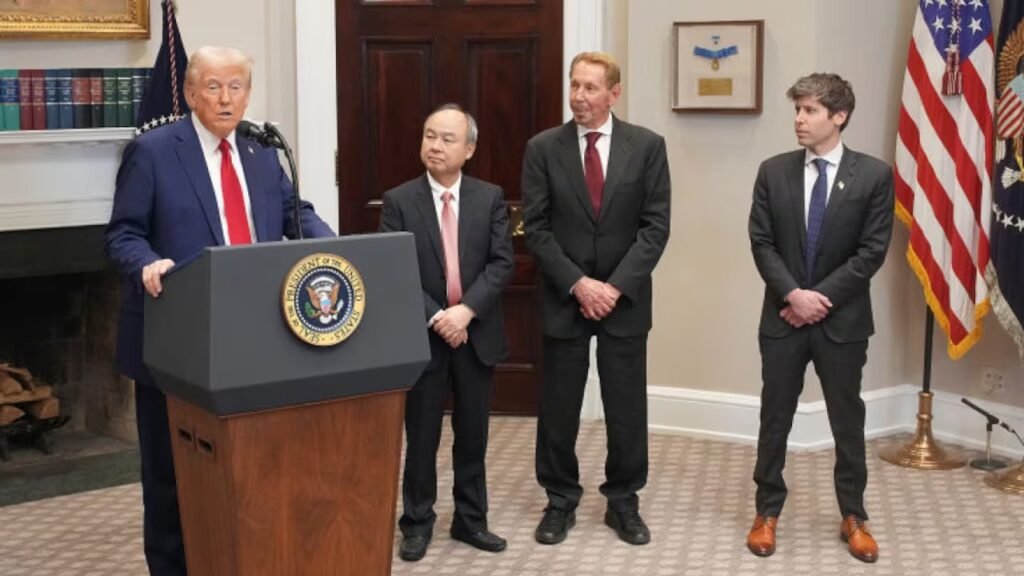
Peter Thiel protégé, and an NRx technocrat in his own right, Sam Altman, stood close to Oracle’s Larry Ellison, SoftBank’s Masayoshi Son and President Trump when Trump announced his administration’s Stargate Project.
According to Altman’s OpenAI:
The Stargate Project is a new company which intends to invest $500 billion over the next four years building new AI infrastructure for OpenAI in the United States. [. . .] The initial equity funders in Stargate are SoftBank, OpenAI, Oracle, and MGX. SoftBank and OpenAI are the lead partners for Stargate, with SoftBank having financial responsibility and OpenAI having operational responsibility. Masayoshi Son will be the chairman. Arm, Microsoft, NVIDIA, Oracle, and OpenAI are the key initial technology partners. [. . .] All of us look forward to continuing to build and develop AI—and in particular AGI [artificial generative intelligence]—for the benefit of all of humanity. We believe that this new step is critical on the path, and will enable creative people to figure out how to use AI to elevate humanity.
“All of us” refers to the global NRx technocrat community of which Sam Altman, Larry Ellison, and Masayoshi Son (Masayoshi Yasumoto) are members. The intention to use AI to “elevate humanity” means to meld us with technology and turn is into programmable “technoplastic beings.”
Masayoshi Son is the head of the technology investment holding company SoftBank Group (SBG) which has capitalised handsomely on its investments in Chinese technology firms such as Alibaba. This is largely due to its control of the Chinese social media firm TikTok, ByteDance, the largest social media company in the world by revenue, is currently valued at around $330 billion. This makes SoftBank’s 4% stake in ByteDance worth roughly $13.2 billion.
It remains to be seen if Larry Ellison’s $14 billion deal to buy out ByteDance’ stake in TikTok’s US operation will help Masayoshi Son’s to increase his ByteDance holdings. Certainly, it should provide him with a healthy dividend. Trump has spoken about “four or five world-class investors” profiting from the deal, but both he and Ellison have been coy about officially naming them.
Project Stargate was launched to much fanfare, in keeping with the rhetoric in the Heritage Foundation’s Project 2025, as the US was supposedly set on a course to outcompete China’s DeepSeek AI development program, which is key to the Hangzhou City-Brain project. Closer scrutiny of Stargate, however, brings the whole notion of competition into question.
Prior to the Stargate launch, in September 2024, Blackrock, its owned subsidiary Global Infrastructure Partners (GIP), Microsoft, and MGX announced their Global AI Infrastructure Investment Partnership (GAIIP) to to fuel AI innovation. This was a worldwide venture but there was a focus on supporting AI innovation in the US. The GAIIP implementing partners included NVIDIA.
As a founding member of GAIIP, UAE-based AI investor MGX is also a “lead partner” in Stargate. MGX is owned by the sovereign wealth fund (Mubadala) of the Emirate of Abu Dhabi ruled by former UAE president Sheik Mohamed bin Zayed Al Nahyan. Shortly after the January 2025 launch of Stargate, in February, Sam Altman visited Abu Dhabi to discuss finance for Stargate with MGX. This resulted in an initial, accelerated $6.6 billion Stargate start-up investment round.
BlackRock, and notably its GIP, receive billions of dollars of private equity investment from China’s state-run investment arms such as the State Administration of Foreign Assets and the China Investment Corporation (CIC). As Trump ramped up his allegedly tough competitive stance against China, by April 2025 the Chinese financiers were pulling back on their enormous US private equity commitments. Doubtless, this was much to the chagrin of Blackrock, MGX and other GAIIP partners.
DeepSeek AI developers in China were reliant on the US-based multinational NVIDIA’s H20 processors which are manufactured under license in Taiwan. NVIDIA is a “key technology partner” of Stargate. Having initially “banned” H20 sales to China, reportedly following some meetings with Jensen Huang—co-founder and CEO of GAIIP partner NVIDIA—the Trump administration started lifting the H20 export ban, more or less as soon as it had been imposed, in April 2025. This later became the official position as, it seems, the initial ban was a mistake.
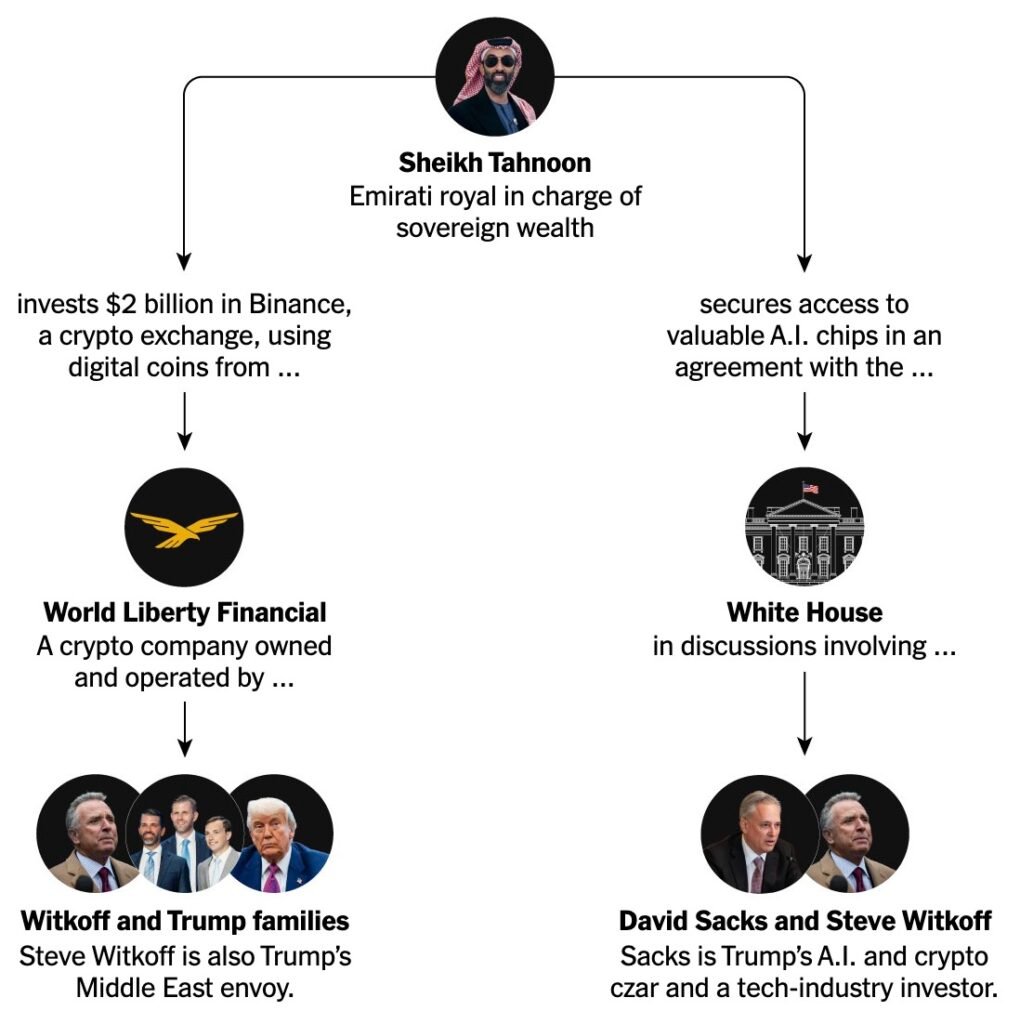
In May 2025, Trump was dispatched to Abu Dhabi where he signed a deal to supply US AI-chips, including NVIDIA processors, to the Abu Dhabi AI digital transformation hub. An associated agreement was made for US tech firms to collaborate on AI development in the Emirate and the wider UAE. Trump called the deal the “U.S.-U.A.E. A.I. Acceleration Partnership.”
In what was clearly a deal sweetener, just a couple of weeks prior to the Trump-UAE deal, Steve Witkoff, Trump’s Middle East envoy, met Sheikh Tahnoon bin Zayed Al Nahyan in Sardinia. Sheik Tahnoon is the Abu Dhabi Emir’s brother, UAE National Security Advisor, and CEO of MGX (Mubadala). Sheik Tahnoon agreed to invest $2 billion in World Liberty Financial, a cryptocurrency venture owned by the Witkoff and Trump families.
Though this looks like blatant corruption, the official fact-checkers have declared everything unimpeachable and have defined the truth for us. Any suggestions that this chain of events clearly evidences high level political corruption have all been officially labelled as “baseless rumours.”
Fact-checking heavyweight Snopes reliably informed us:
While the two deals happened within two weeks and there was an overlap of people who were involved in them, there was no evidence the first, between MGX and World Liberty Financial, was a direct bribe for the second deal, which involved the chips.
So, thankfully, the approved fact-checkers have answered all of our questions for us and that’s an end to the matter.
In the media-spun war of words, and that is evidently all it is, China has now reportedly banned the import of the NVIDIA RTX Pro 6000D—the successor to the H20. But China doesn’t need to import processors from the US because the UAE-China AI partnership, specifically the Abu Dhabi digital transformation hub, has a Trump administration agreement in place for the supply of the processors and it serves as a “crucial base for Chinese AI firms.”
The purported Stargate “competition” with DeepSeek AI looks more like a “partnership.” So what else might be going on here?
When Forbes reported the launch of Stargate on January 2025, its journalists said the “details of the venture are unclear at this early stage.” Why they made this claim is perplexing. The details were not unclear. In November 2024, Sam Altman’s OpenAI, the driving force behind Stargate, announced its “blueprint for U.S. AI infrastructure.”
AI in America: OpenAI’s Economic Blueprint, is Stargate mapped out. This was published before the official White House Stargate announcement and there was no need for any journalist to be “unclear” about any aspect of it.
The “Blueprint” talks about the need to merge “private-sector vision and innovation with public-sector enlightenment to unlock the new technology;” a plan for “building the infrastructure needed to produce enough energy;” investment to develop “the next generation of energy technology, including sustainable sources such as fission, fusion, and other promising technologies;” and it notes the need for “common-sense rules” to help “innovators thrive by encouraging investment [. . .] and greater freedom.”
The NRx technocrat “Blueprint” also defines the alleged need for Freedom Cities:
We need a foundational strategy to ensure that investment in infrastructure benefits the most people possible and maximizes access to AI. This includes policies and initiatives that encourage rather than stifle developers; support a thriving AI-ready workforce and ecosystems of labs, start-ups and larger companies; and secure America’s leadership on AI into the future, such as:
AI Economic Zones, created by local, state and the federal government together with industry, that significantly speed up the permitting processes for building AI infrastructure like new solar arrays, wind farms and nuclear reactors.
These will be what Bloomberg calls “towns free from state law and most federal rules.” Just as the plan for Freedom Cities in the US preceded Stargate, the UK’s deal with Blackrock to develop “freeports” in the UK (see Part 1) had preceded the rollout of the NRx technocrats’ UK Stargate project. It is the same NRx technocrat network imposing the same SEZ-based independent jurisdiction model wherever you look.
Mark Lutter, for example, serves on the board of the Frontier Foundation that was set up to promote the Freedom City initiative in the US. As we discussed in Part 1, Lutter is also the founder and Executive Director of the Charter Cities Institute which states it is proud to support the development of Freedom Cities in the US.Titus Gebel, who wants to profit from migrants and refugees, works closely with Lutter. As previously noted, Lutter served as the head economist for NeWAY Capital and Gebel is a NeWay Capital Partner.
Nick Allen, President of the Frontier Foundation and Lutter’s colleague, is very eager to make use of Trump’s SWF grift and toldWIREDthat federal land close to cities like Boise, Idaho; Grand Junction, Colorado; and Redmond, Oregon would be great places to build gov-corp Technates.
Speaking on behalf of the Frontier Foundation, Allen added:
If we’re able to get a legislative transfer of land from the US government to make a public-private partnership, or a trust, or even a private corporation, then it’s a lower cost of capital. [. . .] There’s so much capital and there’s so much political will, but yet there’s an inability to develop these [frontier] technologies. And the inability comes from lack of space and too many regulations.
NeWay capital established the Freedom Cities Coalition (FCC) which promotes the idea of Freedom Cities as “Cities Without Limits.” This means towns and cities where there are no regulation and oligarchs are free to do what they please. In addition to NeWay Capital, the FCC is also backed by Pronomos Capital led by NRx Technocrats Peter Thiel, Marc Andreessen, and Joe Lonsdale.
The FCC claims that Freedom Cities or, in Stargate terminology, “AI Economic Zones,” represent “America’s boldest solution to unleash our nation’s full potential.” They will be constructed in “zones of regulatory clarity” which will be “specially designated areas” where “entrepreneurs” can “move at the speed of human ingenuity” without having to bother with any overbearing federal laws or regulations.
The FCC adds:
Freedom Cities are more than just economic zones. [. . .] Imagine communities where housing is abundant and affordable, [. . .] where breakthrough technologies move from lab to market at lightning speed because innovators are free to innovate. This is how we’ll overcome stagnation, outcompete China, and create a new American century. Freedom Cities give us the chance to prove once again what Americans can achieve when we’re unshackled from outdated systems and empowered to build the future.
With regard to where the Freedom Cities will be built, the FCC notes:
28% Of US land is federally owned and ready for innovative development.
If the Trump administration’s SWF plans proceed, this will open the door for NRx technocrats and other oligarchs to buy up US territory to build their gov-corp Technates. The political will certainly appears to be there.
Trump’s long-time economic advisor Stephen Moore supports the city-state model. Moore is the former chief economist at the Heritage Foundation, which was behind Project 2025’s Promise to America.
The Trump administration came to power promising to tackle the pernicious influence of “American elites” and was therefore eager to distance itself from the Heritage Foundation’s Project 2025 “Promise,” which was funded by the Koch and Bradley families, among other so-called American elites. Regardless, most of Trump’s Executive Orders, issued when he came to power for the second time, were practically written by the Heritage Foundation’s Project 2025.
The same group of American elites are also behind the State Policy Network (SPN) that proposed the “Compact For America” shortly before Trump’s first US election win in 2016. What Trump termed Freedom Cities in 2023, the Compact for America, whose National Spokesman was Stephen Moore, called Prosperity Districts in 2015. The terminology has changed, but the intention to create gov-corp Technates in the US has not.
As we discussed in Part 1, just as the “authority” is formed to oversee the independent jurisdiction of a Special Economic Zone (SEZ), so the Prosperity District (PD) would be the authority that rules within the jurisdictional boundaries permitted by amenable “Prosperity States” within the US.
Once approved, the PD would wield policing powers, it would control all “municipal services” through public-private partnerships, and set all regulations within its jurisdiction. Just as with the “authority” ruling an SEZ, the PD would expand by petitioning the willing State to expand itself:
The formation or expansion of the PD replaces, within its boundaries, all state laws above the baseline of the state constitution, common law, criminal law and existing compacts. The PDs created within Prosperity States liberate residents, transforming states into strongholds of free markets, federalism and limited government once again.
Safe to say, Trump did not come up with the notion of the Freedom City. It is simply the rebranding for the oligarchs’ Prosperity District idea. The gov-corp Technate has been the NRx technocrat’s favoured path to corporate “prosperity” and social control for more than a decade at this point.
During its first term, the Trump administration tried to put Stephen Moore on the board of the Federal Reserve to ensure favourable monetary policy suited to the formation of Prosperity Districts. The Democratic wing of the Establishment reacted strongly against Moore’s possible appointment and the bid did not succeed. With their second Trump term underway, the NRx Technocrats—the Silicon Valley-based new breed of American elites—have joined forces with their more traditional oligarch partners for the same ends: to build Freedom Cities, Prosperity Districts, SEZs, gov-corp Technates, call them what you like.
The US intelligence community is also onboard. This isn’t surprising given that NRx technocrat’s corporations, such as Peter Thiel’s Palantir and Larry Ellison’s Oracle, have deep ties with US intelligence.
America’s Frontier Fund (AFF), is a supposedly a “nonprofit” venture capital operation with a nonprofit foundation, backed by Bilderbergers Eric Schmidt and Peter Thiel. The AFF is essentially an impact investment cut-out of the US intelligence and national security apparatus. It was founded and is currently led by Gilman Louie. He is the “former” CEO of the CIA’s investment arm In-Q-Tel (1999 – 2006) and thereafter acted as a defence, national security and intelligence advisor for the US government. Notably, Louie was at the helm of In-Q-Tel when it “accelerated” the startup called Palantir.

The AFF’s aim is to harness the “promise of frontier technology.” This is the same “frontier technology” that the UN’s “New Urban Agenda” is based upon, with a view of constructing smart city-states the world over. It is not a coincidence that it is also precisely the same “frontier technology” that the NRx technocrats behind the AFF want to use to enslave humanity. It is, after all, part of the same, global gov-corp Technate plan.
The global agenda, moving us toward digital slavery, is impregnable and is not something any of us can vote are way out of. Our only realistic option is not to comply with the adoption of the “smart” frontier technology people like Gilman Louie, and his intelligence linked network of NRx technocrats want us to adopt.
This entire, global, gov-corp Technate project could not be more anti-democratic. The Dark Enlightenment and the Technocracy favoured by the NRx technocrats represent the zenith of totalitarian ideology. Their oligarch partners enthusiasm to adopt the same Patchwork of city-states is equally born from the desire to control everyone and everything.
Schmidt, Thiel, and Louie were instrumental in setting up the AFF under the previous Biden administration. It would be a mistake to imagine the global agenda to entrap us in smart city-states is a partisan issue. The squabbles we see, such as Democrat opposition to the appointment of Moore to the Fed, are just that: petty squabbles among the ranks.
In 2024, the Future Union, which seeks to “fuse private sector capitalism” with political authority, declared Gilman Louie the “top investor supporting democracy.” Louie narrowly pipped other egalitarian, democracy-loving NRx technocrat investors, like Peter Thiel, Eric Shmidt, and Marc Andreessen, to the top prize. Were the intention of their accelerationist investment strategies not so malevolent we could perhaps laugh at the irony.



